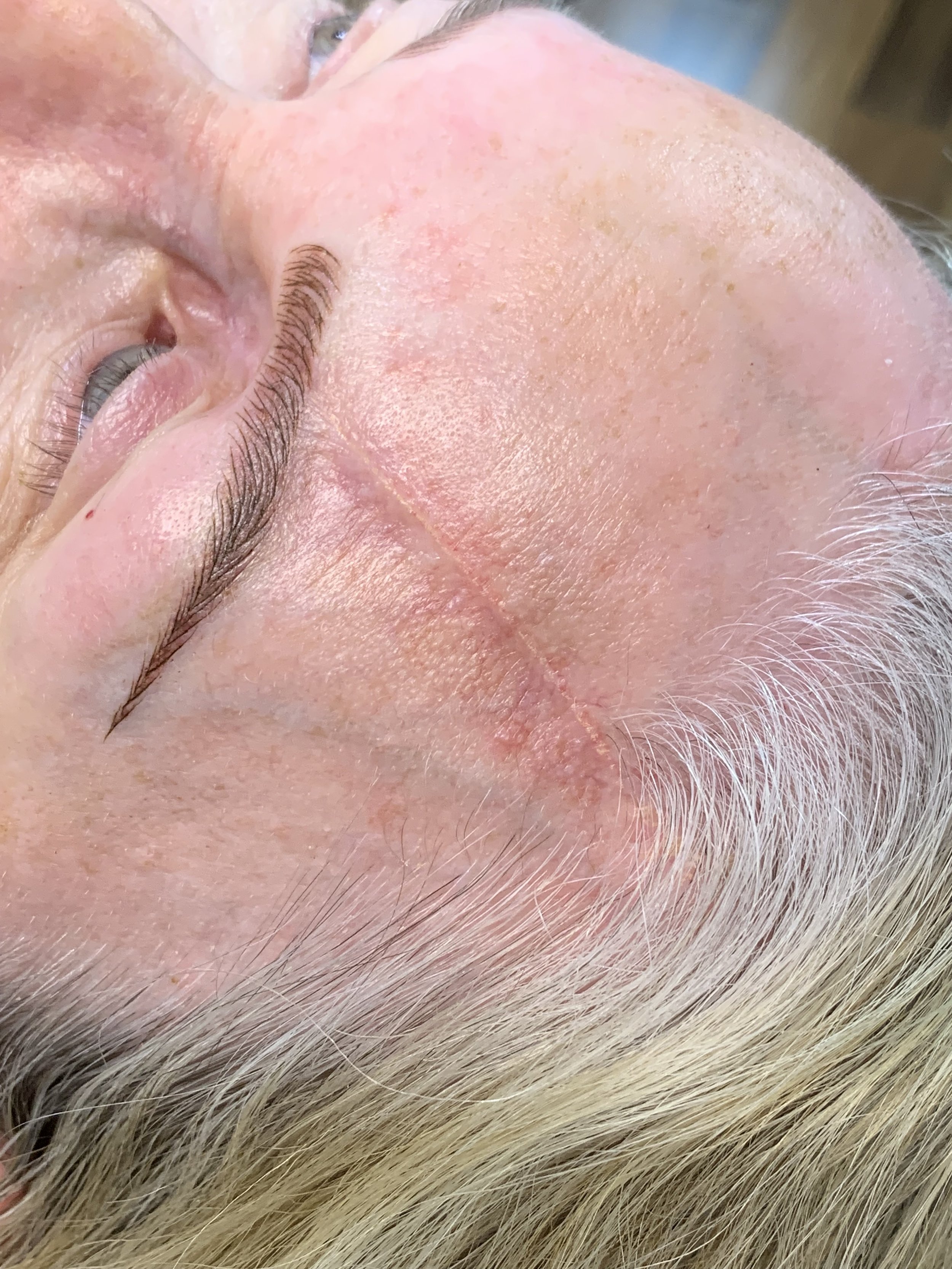Scar/Stretch Mark Camouflage
$200(Per hour)
Includes consultation and initial application.
Includes one area of the face or body per appointment.
This service can be added to an existing PMU Annual Refresh in small areas for a small additional fee.
A $53 non-refundable deposit is required to reserve your appointment and is used towards your total.
Facial scar before camouflage.
Facial scar after camouflage & brows by Rachel.
New toenail added to the big toe that no longer grew a nail.
TYPES OF camouflage
Face - Pigment is placed just below the surface of the skin to create the illusion of a smooth transition between scarring and surrounding tissue. This type of micropigmentation can be done on all types of facial scarring including areas affected by surgery, cancer treatments and grafted skin.
Breast - This type of pigmentation is meant for individuals who have undergone surgery that left the nipple intact, but may have scars or misshapen areolas. These issues are visually improved by evening out the shape, size, and color of the nipple and/or scar tissue.
Torso, arms and legs - Scarring and stretch marks on the torso, arms and legs are easily addressed by tattooing pigmentation over the affected areas. This type of micropigmentation can be done on all types of bodily scarring and stretch marks including healed surgical sites, stretch marks and grafted skin.
PLEASE NOTE: All services will be charged tax. Due to updated safety protocol, an additional $5.00 may be charged to each guest for the addition of PPE. Any service performed at a studio other than Total Image Salon, in Berkeley Springs, West Virginia will include an additional $25 fee.
BASIC INFORMATION
Tattooing by definition is a form of body modification in which ink is inserted into the dermis layer of the skin. Paramedical tattooing focuses on the restoration of the skin. It is a critical step in the healing journey of the survivors of cancer, accident, illness, trauma, surgery and injury. Unlike traditional tattoos where art is the focal point and purpose, paramedical tattooing is designed to conceal and camouflage. It can cover unwanted burn scars, birthmarks, dark and off-color skin patches such as Vitiligo or age spots and rebuild body parts to create a balanced appearance.
Pain during the treatment is relative. Scared guests usually feel stronger pain, while the other guests compare such pain with the one that they feel when plucking hair or experiencing a bee sting. In addition, it is not recommended to do the treatment while menstruating or during times of extreme fatigue due to an increased sensitivity to pain. It is possible to use light anesthetics, in the form of gel, to eliminate some sensitivity during the procedure (if an allergy to the components is not present.)
Treatment is done by using sterile and disposable cartridges, while pigments and inks are of the highest standard (Dynamic Ink, Ever After Pigments or Almost Famous). Inserted ink is very dark during the first 5 to 7 days. Seven days later, it loses up to 40% of its intensity. If you think that ink is too dark, do not try to fade it by yourself. The duration of ink retention in your skin depends on the skin oiliness and scarring. Sweating and sun exposure also affect ink retention and you must avoid both for up to one month after treatment. Healing is usually completed around 30 days after the procedure.
Post-procedure care makes 70% of total treatment success. Conscientiously adhere to the given aftercare in order to avoid ink loss as well as infection.
How successful the treatment will be depends on:
skin quality and age of scar tissue
post-treatment care
exposure to various external influences
None of these factors are under the Artist’s control, thus providing any guarantee for the treatment is not possible.
Please consult with your artist if you:
have problematic skin
have serious health issues or have undergone surgery in the treatment area (please have a doctors pre-approval)
take certain medications
already have existing paramedical tattooing
Complications are possible and include, but are not limited to the following: discomfort, scabbing, bruising, swelling, scarring, allergic reaction, infection, pigment migration, color/change, sensitivity in the tattooed area, Sarcoidosis, Koebner, Ectropion, eyelid necrosis, the loss of eyelashes and secondary cicatricial ectropion. It is also important to note that botulin toxin and/or filler injection and plastic surgery of the face can change the appearance and lead to the distortion of camouflage tattooing.
BEFORE THE TREATMENT
Before each treatment, the skin should not be burnt, nor in recovery or in a regenerative process. If your scar tissue is still pink, it is not recovered enough to undergo treatment. If you are unsure, please consult with Rachel. It is also recommended that you become familiar with the post-treatment aftercare procedures.
The following are not recommended 30 days before the treatment in the treatment area:
Botox and fillers
avoid caffeine and alcohol
laser treatments
chemical peel
exposure to strong sunlight
** Please see the full list of pre-procedure advice on the Paramedical page of this website for further information.
AFTERCARE
Each guest receives an aftercare kit that includes all of the necessities to care for the treatment area. Aftercare kits are provided after each visit. Please use these items as directed and contact Rachel with any questions or concerns.
Aftercare instructions are listed on a separate page in the dropdown menu.
Facial scar before camouflage.
Facial scar after camouflage & annual brows by Rachel.






